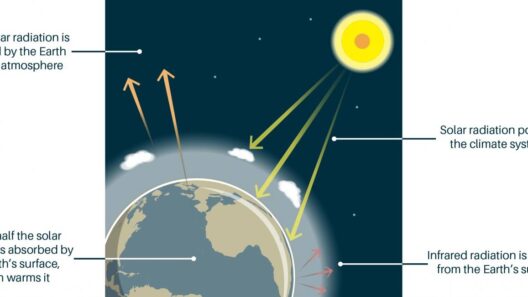Understanding the significance of the greenhouse effect is crucial for appreciating the delicate balance that sustains life on Earth. While often vilified in discussions about climate change, the greenhouse effect is a natural phenomenon that keeps our planet warm enough to support diverse ecosystems. This article aims to elucidate the importance of greenhouse gases in maintaining a habitable Earth while addressing their implications in today’s context of global warming.
The greenhouse effect operates on a fundamental principle: certain gases in the atmosphere trap heat that radiates from the Earth’s surface. By creating a thermal blanket, these gases help to raise and stabilize the planet’s temperatures. Without this effect, Earth would be inhospitable to the vast array of life forms that inhabit it today. The primary greenhouse gases include carbon dioxide (CO2), methane (CH4), nitrous oxide (N2O), and water vapor, each contributing uniquely to this vital process.
The delicate balance of nature hinges on the right amount of greenhouse gases—too little could result in a frigid world, while excess can lead to severe climate disruptions. Understanding how these gases function explains not only their necessity but also their vulnerabilities, especially as human activities continue to alter their concentrations.
The Role of Greenhouse Gases in Climate Regulation
Greenhouse gases, due to their unique molecular structures, can absorb and emit infrared radiation. This ability allows them to maintain a thermal equilibrium that is essential for sustaining life. Water vapor is the most prevalent greenhouse gas and is responsible for about 60% of the greenhouse effect. It amplifies the impact of other greenhouse gases, acting as a feedback mechanism rather than a direct driver of climate change.
Carbon dioxide, on the other hand, is the most significant anthropogenic greenhouse gas. It is released during the combustion of fossil fuels, deforestation, and various agricultural practices. Its high durability in the atmosphere—often lingering for centuries—means that once emitted, it continues to affect global temperatures for an extended period. This longevity makes the management of CO2 emissions fundamental in global climate strategies.
Methane, while less prevalent in the atmosphere, has a potency that is over 25 times greater than that of carbon dioxide over a 100-year period. It is released from agricultural activities, landfills, and the production of oil and gas. Moreover, the shorter atmospheric lifespan of methane (approximately a decade) makes it a critical target for immediate emissions reduction efforts to slow down short-term warming.
Understanding how these gases interact with solar radiation is crucial for grasping the intricacies of climate regulation. The Earth receives energy from the sun, which is absorbed and reflected back into space. Greenhouse gases impede the latter, trapping heat in the atmosphere, thereby fostering a warming effect that is vital for life on Earth.
Consequences of Greenhouse Gas Emissions
While greenhouse gases are essential for maintaining livable conditions, their excess poses significant threats. The anthropogenic activities leading to increased emissions have exacerbated natural phenomena, resulting in dramatic climate alterations. These changes manifest through rising global temperatures, fluctuating weather patterns, and more frequent extreme weather events.
One notable consequence of elevated greenhouse gas concentrations is the increase in the Earth’s average temperature, often referred to as global warming. This temperature rise leads to the melting of ice caps and glaciers, contributing to rising sea levels that threaten coastal communities and ecosystems. Additionally, warmer temperatures can intensify droughts and floods, creating adverse impacts on agriculture and food security.
The warming of the oceans, another critical concern, leads to coral reef bleaching and significant disruptions to marine biodiversity. The cascading effects of climate change not only endanger wildlife but also jeopardize human health, economic stability, and societal structures.
Mitigating Greenhouse Gas Emissions: Steps Toward Sustainability
Addressing the challenges posed by greenhouse gases requires a multifaceted approach. Transitioning towards renewable energy sources, such as solar and wind, is vital in reducing carbon emissions from fossil fuels. Enhancing energy efficiency in industries and households also plays a crucial role in decreasing overall energy consumption and associated emissions.
Another critical avenue is reforestation and afforestation. Trees absorb carbon dioxide, effectively removing it from the atmosphere. By preserving existing forests and planting new trees, we can bolster nature’s ability to regulate CO2 levels, a practice that benefits biodiversity and strengthens ecosystems.
Moreover, innovations in technology, such as carbon capture and storage (CCS), offer potential pathways to mitigate emissions from industries that are challenging to decarbonize. Increased public awareness and advocacy for sustainable practices can drive changes at both the individual and policy levels, fostering a collective responsibility towards environmental stewardship.
In conclusion, while greenhouse gases are often framed negatively in discussions about climate change, their role in maintaining Earth’s habitability cannot be overstated. Their intricate balance is essential for life as we know it, but this balance is being perturbed by human activity. Understanding the natural processes surrounding the greenhouse effect is crucial as we strategize to protect our planet for future generations.








